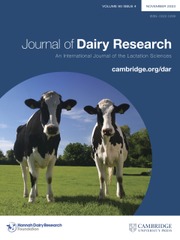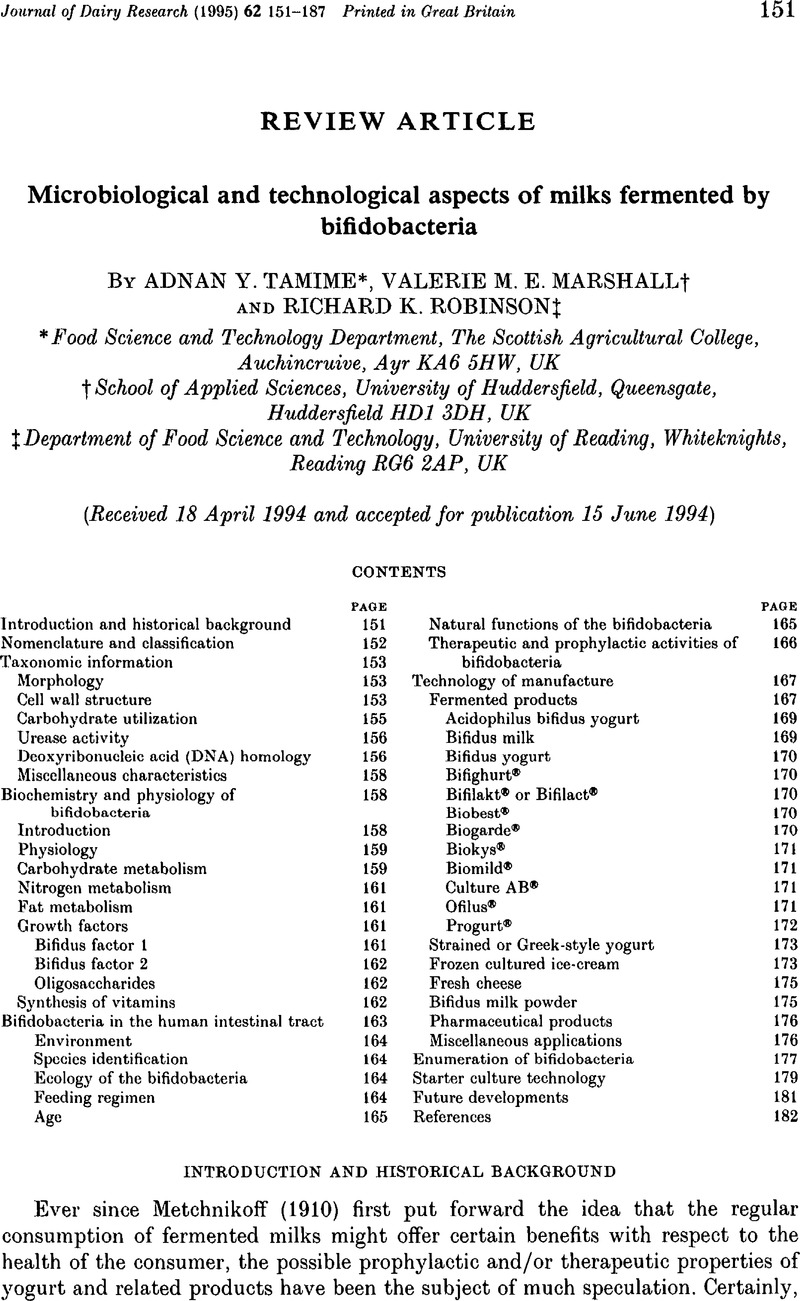Crossref Citations
This article has been cited by the following publications. This list is generated based on data provided by Crossref.
Blanchette, L.
Roy, D.
Bélanger, G.
and
Gauthier, Sylvie F.
1996.
Production of Cottage Cheese Using Dressing Fermented by Bifidobaceria.
Journal of Dairy Science,
Vol. 79,
Issue. 1,
p.
8.
Hartemink, R.
Kok, B.J.
Weenk, G.H.
and
Rombouts, F.M.
1996.
Raffinose-Bifidobacterium (RB) agar, a new selective medium for bifidobacteria.
Journal of Microbiological Methods,
Vol. 27,
Issue. 1,
p.
33.
Ghoddusi, Hamid B.
and
Robinson, Richard K.
1996.
Enumeration of starter cultures in fermented milks.
Journal of Dairy Research,
Vol. 63,
Issue. 1,
p.
151.
Marshall, V M
and
Tamime, A Y
1997.
Starter cultures employed in the manufacture of biofermented milks.
International Journal of Dairy Technology,
Vol. 50,
Issue. 1,
p.
35.
Tamime, A. Y.
and
Marshall, V. M. E.
1997.
Microbiology and Biochemistry of Cheese and Fermented Milk.
p.
57.
Rada, V.
1997.
Effect ofKluyveromyces marxianus on the growth and survival of bifidobacteria in milk.
Folia Microbiologica,
Vol. 42,
Issue. 2,
p.
145.
Kot, Eva
Furmanov, Sergey
and
Bezkorovainy, Anatoly
1997.
Binding of Fe(OH)3toLactobacillus delbrueckiissp.bulgaricusandLactobacillus acidophilus: Apparent Role of Hydrogen Peroxide and Free Radicals.
Journal of Agricultural and Food Chemistry,
Vol. 45,
Issue. 3,
p.
690.
1998.
Micro-Organisms in Foods.
p.
521.
Gardiner, G.
Ross, R. P.
Collins, J. K.
Fitzgerald, G.
and
Stanton, C.
1998.
Development of a Probiotic Cheddar Cheese Containing Human-Derived
Lactobacillus paracasei
Strains
.
Applied and Environmental Microbiology,
Vol. 64,
Issue. 6,
p.
2192.
Schillinger, U
1999.
Isolation and identification of lactobacilli from novel-type probiotic and mild yoghurts and their stability during refrigerated storage.
International Journal of Food Microbiology,
Vol. 47,
Issue. 1-2,
p.
79.
Tamime, A.Y.
1999.
Encyclopedia of Food Microbiology.
p.
1355.
Rycroft, Catherine E.
Fooks, Laura J.
and
Gibson, Glenn R.
1999.
Methods for assessing the potential of prebiotics and probiotics.
Current Opinion in Clinical Nutrition and Metabolic Care,
Vol. 2,
Issue. 6,
p.
481.
ETOH, Shin-ichi
SONOMOTO, Kenji
and
ISHIZAKI, Ayaaki
1999.
Complementary Effects of Bifidogenic Growth Stimulators and Ammonium Sulfate in Natural Rubber Serum Powder onBifidobacterium bifidum.
Bioscience, Biotechnology, and Biochemistry,
Vol. 63,
Issue. 4,
p.
627.
Litopoulou-Tzanetaki, E.
and
Tzanetakis, N.
1999.
Encyclopedia of Food Microbiology.
p.
774.
Daigle, A.
Roy, D.
Bélanger, G.
and
Vuillemard, J.C.
1999.
Production of Probiotic Cheese (Cheddar-Like Cheese) Using Enriched Cream Fermented by Bifidobacterium infantis.
Journal of Dairy Science,
Vol. 82,
Issue. 6,
p.
1081.
Kebary, K. M. K.
and
Hussein, A. S.
1999.
IMPROVING VIABILITY OF BIFIDOBACTERIA BY MICROENTRAPMENT AND THEIR EFFECT ON SOME PATHOGENIC BACTERIA IN STIRRED YOGHURT.
Acta Alimentaria,
Vol. 28,
Issue. 2,
p.
110.
Naidu, A
and
Clemens, R
2000.
Natural Food Antimicrobial Systems.
Kailasapathy, Kaila
and
Chin, James
2000.
Survival and therapeutic potential of probiotic organisms with reference to Lactobacillus acidophilus and Bifidobacterium spp..
Immunology & Cell Biology,
Vol. 78,
Issue. 1,
p.
80.
Rada, V
and
Petr, J
2000.
A new selective medium for the isolation of glucose non-fermenting bifidobacteria from hen caeca.
Journal of Microbiological Methods,
Vol. 43,
Issue. 2,
p.
127.
Hou, Jen-Wan
Yu, Roch-Chui
and
Chou, Cheng-Chun
2000.
Changes in some components of soymilk during fermentation with bifidobacteria.
Food Research International,
Vol. 33,
Issue. 5,
p.
393.


